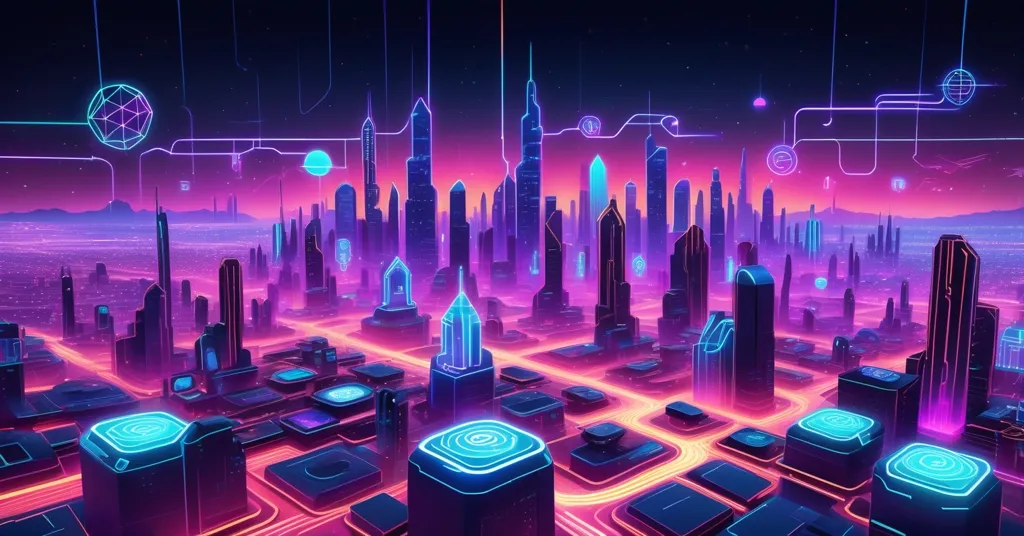Astra Nova’s $RVV Token Launch: NVIDIA, Shiba Inu, and Saudi Arabia Back Web3 Game Changer

Nvidia, Shiba Inu, and Saudi Arabia Back Astra Nova’s $RVV Token Launch: A Web3 Game Changer?
Can a token launch backed by tech giants, meme coin legends, and a futuristic desert city redefine the Web3 space? Astra Nova’s $RVV token, set to debut on October 18, is making bold claims with support from NVIDIA, the Shiba Inu founding team, Saudi Arabia’s NEOM project, and Alibaba Cloud. This isn’t just another cryptocurrency token launch—it’s a potential fusion of AI-blockchain integration and real-world utility that could shake up decentralized tech. But as a Bitcoin enthusiast with a sharp eye for fluff, I’ve got questions. Let’s dig into what makes this project tick and whether the hype holds water.
- Launch Date: $RVV token launches on October 18 with a Binance campaign in tow.
- Powerhouse Backers: NVIDIA, Shiba Inu team, Saudi Arabia’s NEOM, and Alibaba Cloud bring tech, community, capital, and scale.
- Big Promise: Astra Nova’s TokenPlay AI platform aims to blend AI-driven apps and games with blockchain innovation.
NVIDIA: The AI Powerhouse Behind Astra Nova
When a tech titan like NVIDIA throws its weight behind a Web3 project, ears perk up. Astra Nova is part of NVIDIA’s Inception program, a prestigious initiative for AI startups, granting access to GPU-accelerated computing—the kind of tech that powers self-driving cars and cutting-edge robotics. As a spokesperson noted:
“Astra Nova gets access to the same technology that powers self-driving cars and advanced robotics.”
For the uninitiated, think of GPUs as turbocharged engines for heavy tech lifting. They crunch massive data sets for machine learning or render complex graphics at lightning speed. In a blockchain context, this means Astra Nova’s TokenPlay AI platform—designed for decentralized apps (dApps) and games—can process intense workloads without choking. dApps, by the way, are applications running on a global network of computers, not owned by any single entity like Google or Apple, embodying the decentralized spirit we cherish in crypto.
Why does this matter? Most blockchain projects struggle with speed and efficiency. NVIDIA’s tech could give Astra Nova an edge, making dApps smoother and more user-friendly. As a Bitcoin maximalist, I’ll admit this doesn’t directly bolster BTC’s mission as sound money, but practical Web3 tools can drive broader crypto adoption—indirectly lifting Bitcoin’s tide by expanding the ecosystem. Still, tech alone isn’t a golden ticket. Let’s see if the other pieces fit.
Shiba Inu: Meme Magic Meets Web3 Innovation
Next up, we’ve got the Shiba Inu connection. Key members of the team behind this meme coin, which ballooned into a multi-billion-dollar ecosystem, are now working on Astra Nova. Shiba started as a Dogecoin knockoff but morphed into a cultural juggernaut, proving viral hype can translate into lasting value with smart community-building. Their expertise is already live through TokenPlay AI MiniApps—bite-sized, user-friendly applications within the platform to hook early adopters.
Community is the heartbeat of crypto. Bitcoin’s own strength lies in its unshakable supporters, and Shiba’s team knows how to rally a crowd. In a landscape littered with rug pulls and ghost projects, that’s a serious weapon. But let’s not kid ourselves—meme coin pedigree can be a double-edged sword. Will their magic work for a Web3 infrastructure project, or is this just recycled hype? Success hinges on whether TokenPlay AI delivers beyond viral buzz. If it does, they could onboard a legion of users into decentralized tech, a win for the broader crypto space.
NEOM: Geopolitical Giant or Centralization Risk?
Now, let’s talk about the wildcard: Saudi Arabia’s involvement through NEOM. For those new to this, NEOM is a $500 billion futuristic city project, a flagship of the kingdom’s shift from oil to tech-driven economies. With partnerships alongside NVIDIA and Oracle for AI capabilities, NEOM isn’t just a sandbox—it’s a trillion-dollar bet on innovation. Astra Nova’s alignment suggests not just financial backing but potential access to infrastructure, government contracts, and a favorable regulatory environment. Think of a regulatory sandbox as a playground where governments ease rules for experimental tech, letting projects like this test ideas without red tape.
Nation-state backing in crypto is rare and signals legitimacy. Saudi Arabia sees AI and blockchain as strategic pillars, and Astra Nova could play a role in tokenized smart city services or AI-driven urban planning on the blockchain—use cases that align with NEOM’s sci-fi vision. But here’s the rub: for us Bitcoin diehards, any whiff of government overreach is a red flag. Decentralization isn’t just tech; it’s a philosophy. Governments don’t have a shining track record on privacy—look at China’s social credit systems or even Ripple’s SEC battles over perceived centralization. If NEOM pulls strings, could Astra Nova’s blockchain become a surveillance tool dressed in Web3 clothing? I’m rooting for disruption, but this geopolitical tightrope keeps me up at night.
Alibaba Cloud: The Scalability Backbone
Rounding out this coalition is Alibaba Cloud, one of the world’s largest cloud providers, operating across 91 availability zones in 29 global regions. They’re the infrastructure muscle behind TokenPlay AI, integrating NVIDIA’s AI tools to ensure the platform doesn’t buckle under high traffic or transaction volumes. Scalability isn’t glamorous, but when Ethereum gas fees hit wallet-melting levels during NFT frenzies, you realize why it’s make-or-break. Many crypto projects collapse under their own weight—Alibaba Cloud’s enterprise-grade backbone means Astra Nova is less likely to flop when adoption spikes.
Compared to other Web3 solutions leaning on AWS or Google Cloud, Alibaba’s global reach and focus on AI integration give Astra Nova a tailored edge for handling dApp demands. Yet, Big Tech isn’t exactly a cypherpunk darling. Alibaba’s involvement raises the same centralization concerns as NEOM—how much control does a corporate giant wield over a supposedly decentralized platform? No project is fully immune to scaling hiccups, and post-launch stress tests will reveal the truth. Still, on paper, this is a robust foundation for a Web3 gaming platform aiming for mass use.
A Coalition to Rewrite the Web3 Playbook?
Taken together, these backers form a synergy that’s tough to overlook. As one observer put it:
“Separately, each is impressive. Together, they cover every base a Web3 infrastructure project needs: technology, scalability, capital, and community.”
Analysts are already calling the $RVV token launch one of 2025’s most anticipated crypto events, with a low starting market cap in the single-digit millions and revenue potential from platform fees. But let’s cool it on the rocket emoji frenzy. I’m bullish on decentralized tech, but we’ve seen too many “game-changers” fizzle out like bad ICOs. Partnerships don’t guarantee success—the market will decide $RVV’s fate. With a Binance campaign tied to the launch, expect a trader feeding frenzy. Pumps and dumps happen faster than you can blink, so tread carefully. We’re not here to peddle price fantasies; our job is to cut through the noise.
Where Does Astra Nova Fit in the Crypto Landscape?
For Bitcoin purists like myself, Astra Nova might feel like a sideshow. BTC is the unchallenged king of decentralization—its simplicity as sound money is battle-tested. No altcoin or flashy platform matches that purity. Unlike Bitcoin’s laser focus, Astra Nova’s complexity could be its downfall or its breakthrough. But I’m also pragmatic. Web3 projects and altcoins fill gaps Bitcoin doesn’t (and shouldn’t) touch. AI-driven crypto projects, tokenized gaming ecosystems, and decentralized AI tech can onboard millions, indirectly strengthening Bitcoin’s network by growing the pie. Ethereum did it with smart contracts; Astra Nova could do it with AI.
Compare this to other AI-blockchain hybrids like Fetch.AI or SingularityNET, which also blend machine learning with decentralized systems. Astra Nova’s edge lies in its heavyweight backers and focus on gaming—a sector ripe for blockchain disruption with microtransactions and NFT ownership. Yet, competition is fierce, and utility is king. TokenPlay AI’s specific apps, games, or monetization models beyond “platform fees” remain vague. Are they targeting casual gamers, hardcore crypto natives, or both? Without concrete deliverables, even the best coalition risks becoming another hyped shell.
The Dark Side: Centralization and Hype Risks
Let’s not ignore the elephant in the room: centralization risks. Saudi Arabia’s deep pockets and NEOM’s futuristic allure are tempting, but nation-state involvement could clash with crypto’s ethos of freedom. Historical parallels don’t inspire confidence—EOS faced governance scandals over centralized control, and Ripple’s legal woes highlight how “decentralized” projects can attract regulatory heat. Alibaba Cloud, while technically vital, adds another layer of Big Tech influence. Will Astra Nova’s blockchain truly empower users, or will it bend to external powers?
Then there’s the hype factor. Slick partnerships can blind us to red flags. The crypto space is a graveyard of broken promises—remember the 2017 ICO bubble? Astra Nova must prove its worth beyond buzz. In true cypherpunk spirit, question everything—especially when big dogs are at the table. Effective accelerationism, pushing tech forward at warp speed, is my jam, but not at the cost of core principles like privacy and autonomy.
What’s Next for $RVV?
As October 18 looms, Astra Nova faces a litmus test. Can it marry AI innovation with blockchain’s promise of disruption while staying true to decentralization? Post-launch milestones—user adoption stats, dApp rollouts, or revenue figures—will separate fact from fiction. For Bitcoin maximalists, this might be a curiosity; for altcoin explorers and Web3 enthusiasts, it’s a potential frontier. I’m optimistic but grounded. With backers like these, Astra Nova has a shot to carve a meaningful niche—just don’t swallow the hype until the results speak.
Key Takeaways and Questions on Astra Nova’s $RVV Launch
- What sets Astra Nova’s $RVV token launch apart in the crowded crypto market?
Its unique mix of NVIDIA’s AI tech, Shiba Inu’s community know-how, Saudi Arabia’s NEOM backing, and Alibaba Cloud’s scalability makes it a comprehensive contender in Web3 innovation. - How does NVIDIA’s involvement boost Astra Nova’s potential?
Through the Inception program, NVIDIA provides GPU-accelerated computing—think self-driving car tech—powering TokenPlay AI for faster, smarter decentralized apps and games. - Why is Saudi Arabia’s NEOM support a big deal—and a concern?
NEOM’s $500 billion investment offers capital and infrastructure, but government involvement raises risks of centralization, clashing with crypto’s privacy and autonomy ideals. - Can Shiba Inu’s team drive Astra Nova’s success?
Their proven ability to build engaged communities is a huge asset, but success depends on TokenPlay AI delivering real utility beyond meme-driven excitement. - Does Alibaba Cloud solve Astra Nova’s scalability challenges?
With global infrastructure across 91 zones, Alibaba Cloud provides a strong base to handle growth, though real-world tests post-launch will confirm if hiccups persist. - Should Bitcoin enthusiasts care about Astra Nova?
While not directly tied to BTC’s mission, Astra Nova could expand crypto’s reach through Web3 and AI, indirectly benefiting Bitcoin by onboarding new users to the ecosystem.



